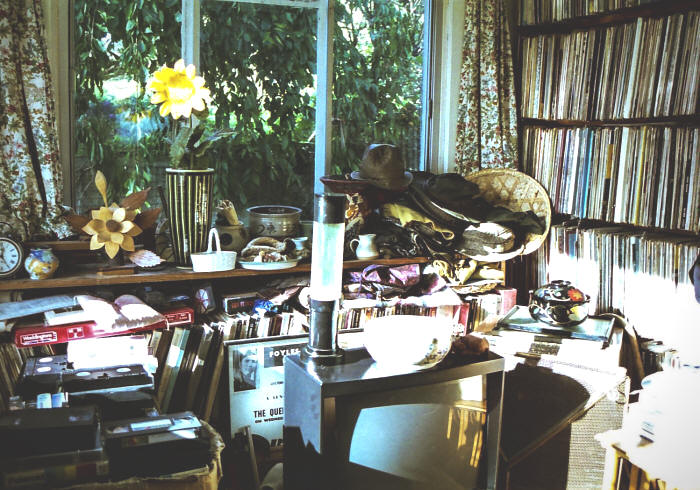|
|
| home | exhibitions | interviews | features | profiles | webprojects | archive |
|
Joy Wilson and Colin Stanley on Colin Wilson interview by Rupert White. photos by Keiko Tsutsumi and Paul Broadhurst.
RW How did you and Colin end up living in Cornwall, Joy?? JW We lived in this house, Chepstow Villas (in Notting Hill), that was full of odd people. It was owned by a lady called Anne Nichols who lived on the premises. Her mother had given the house to her. Anne was an artist herself, and she invited people that she ran into in Soho, to live there. So she had quite a motley assembly there. We had a little room by the front door out on stilts and it was jolly cold in winter. But it was just right for two people. A year or so afterwards a chap called Potter moved in next door. His brother was a poet called Louis Adeane – he'd adopted this as a pen-name. Once, when Louis was visiting his brother, he said: 'If you're looking to get out of London I wonder if you'd be interested in my cottage. I can't really afford the rent - it's 30 shillings a week - but I love the place so much I don't want to give it up. So it would be a great boon to me if you did go down there'. So Colin, because he was wanting to get out of London then, because the press had been bothering us so much, said yes he would be, but he would like to see it first. We came down with Louis on the steam train. The fare was £2. And Louis put us up with Derek Savage who was another writer. RW I know about some of these people because of Paul Newman, who used to write for artcornwall.org JW Yes, Paul wrote a book on the Mevagissey thinkers. Derek is included in that. So we stayed overnight with Derek, who Colin already knew because he'd made his name writing two books of criticism in the Eliot style. One was called 'The Withered Branch'. He'd made his name in London but he also ran this boarding house in Mevagissey, and we stayed there. And then Louis took us to his cottage which is about a mile and a half out of Mevagissey towards Gorran, right up a valley that leads down to a little beach. It's still there. When we lived there it didn't have any facilities. It had oil lamps and water from the stream to wash in and a well in the garden. So it was fairly basic. But lots of young people lived in cottages like that at the time. There were other people living over in Heligan. All sorts of people from Soho knew about these cottages. There was this little contingent of refugees from Soho. Louis only had to show us his cottage and take us for a walk on the cliff and we just said 'oh yes'. It was April and there were masses of wild flowers on the cliff edge. You don't see them like that any more. And we said 'yes, we'll stay here for 6 months'. But we ended up there for two years until we got a letter from Louis. Colin said 'what are we going to do if we have to move out? We've got all these records, and books'. We thought we better find somewhere else, and we stumbled across this house. RW Tetherdown. And you've been here ever since? JW Yes. And as soon as we got here we found it was a good machine for living in. 1959 was the year we moved in. It was empty. We just had a bed and one armchair. RW Did Colin feel a bit isolated in Cornwall? JW No. He felt it was ideal because he didn't have to bother with anybody unless he wanted to. RW And you had friends. Lionel Miskin from Falmouth School of Art lived in Mevagissey didn't he? JW Yes. He was a good friend. He had a bungalow opposite Derek Savage. It was a lovely Queen Anne house. They were both established here before we were. And there were other writers that Paul wrote about. So Bernard Walke was here. He was the vicar of St Hilary. He had to leave because he contracted TB, and came to Mevagissey to convalesce.
RW Did you and Colin visit Museum of Witchcraft (MoW) in Boscastle? JW Yes. Colin knew Cecil Williamson. He didn't think he was witchlike at all! But he was certainly knowledgeable. RW Colin doesn't mention the MoW in 'The Occult' (1971) JW He'd already have been there earlier out of curiosity and met with Cecil Williamson who'd have shown him all around. And we knew Ronnie Duncan, the poet, who had a farm up there in the same area. RW Thinking about The Occult Trilogy, Colin also wrote about TC Lethbridge and dowsing ('Mysteries', 1978). Did he do much dowsing himself? JW No. Because he didn't have a lot of time to do it. But he did become interested. We went with a friend (John Le Carre) to the Merry Maidens, and he experimented and felt it immediately. I can do it and in fact a lot of people can. We went to other stone circles after that, and he became more interested through reading Lethbridge's books. RW There's a photo of him dowsing at the Merry Maidens that was published in Fortean Times. JW That was about the first time he did it. He was quite surprised that it worked for him because he always used to say that he wasn't at all psychically gifted. But quite astonishingly he found that that worked. And we got to know various dowsers as a result. Colin never thought he had second sight or ESP, but he wasn't disbelieving about it. He liked the more practical approach. CS That was the scientist in him. JW He wanted to get to the bottom of it. How come we've got these gifts that we don't use? Its not a mystery its just something we have n't cultivated properly.
RW He did talk about having 'peak experiences', though didn't he? And he corresponded with eminent psychologist Abraham Maslow (known for his 'hierarchy of needs') about these special moments of insight... JW We met Maslow in New York. CS It was Maslow who first got in touch with Colin. He'd read Colin's book 'The Age of Defeat' which was published in the States as The 'Stature of Man'. He wrote to Colin in the early 60's and their relationship took off after that. RW I have a sense that Maslow took Colin's thinking in a new direction? CS Actually they were thinking along the same lines. JW Maslow was not that well known then, except amongst the Esalen contingent. He invited us to the University. He was very unassuming but extremely friendly and interesting. His home was in The Village in New York. I remember wandering around New York with him. Colin saw him on more occasions than I did because he used to do lecture tours in the US. RW Paul Devereux, editor of The Ley Hunter, says he remembers meeting you in NY JW We knew Paul quite well. He came to the house here. Colin went on lecture tours in the early 60's on his own. Then in 1966 Colin was invited to be a writer in residence at this girl's school in Virginia, and went and lived there for an academic year. And he was encouraged to travel about a bit. The next year we went to the University of Washington in Seattle. We spent quite a bit of time in the States at that time. RW Did you help Paul Devereux collect data for The Dragon Project (which was an attempt to measure 'earth energies' of various kinds)?
I had to do extensive measurements. You got certain measure-ments inside the circle, and then you had to walk 100 yards away and try again, and the measurements were different. Some of the stones in the circles gave more signal than others. You had to send the results in, and I think he pooled them from all over the country. RW He wrote up some of these results (Places of Power, 1990), but then he became specifically interested in dreaming at sacred sites. JW He took to sleeping in caves. I remember he told us about this, saying we should try it, but I thought it sounded very draughty! He said the dreams are very interesting. There was quite a lot of work involved. As well as the actual circle that you visited, you had to have an imaginary circle in a field. I did one in the garden here, and one outside St Austell in places where as far as you know there was nothing. And there was a signal from the Geiger counter but not as pronounced as around the stones. RW You've written some local history studies eg on Tristan and Iseult, I believe, Joy. Cornish studies has become quite a 'thing' in the last 50 years or so. And Cornish language studies. CS Did you ever learn to speak Cornish Joy? JW No, but I do know about place names. James Whetter can speak Cornish. He lives up the road from me. I'm a bard so I sing in Cornish when I go to the Gorseth. James put my name forward originally. You have to have two sponsors. I was initiated on the rugby field in Camborne. It was a bit of a disappointment, and we had to go indoors because the weather was so appalling. The best one I went to was at St Ives on the flank of the Island, on a nice grassy green patch and it was a perfect day. The last one was on the rugby field in St Austell, but its high up and you can see all around, so it was good in a different way. CS Do you have any special robes?? JW Oh yes. The headdress is a real problem because my head seems to have shrunk! It seems to slip down over my nose. I only discovered this as I was promenading around St Ives! RW Do you remember Tony 'Doc' Shiels? JW Oh yes. We knew him quite well. He's been to this house. He took us on a promenade on the banks of the Fal, I think in the Roseland area, explaining where we can see Morgawr the sea monster, which according to him was visible in the Fal. We thought, though, that he was 'legend-building'.
RW He lives in Ireland now. He was an artist originally, and lived in St Ives in the late 50's. He took photos of Loch Ness Monster. JW He was very jolly. The last time we saw him was in London. He was being very histrionic. May be at the Fortean Times convention. RW Colin wrote a foreword for Doc Shiels' book Monstrum. Colin was very generous in that regard. He also did so for Paul Broadhurst (author with Hamish Miller of 'The Sun and the Serpent' - pictured above with Colin Wilson and Robin Hanbury -Tenison). CS I've found 180 books that he wrote forewords to. I did ask him once why he wrote so many forewords. He did them for nothing. He said 'when I was a child I read a lot of GK Chesterton, and he used to write a lot of forewords'. JW Colin was interested in Paul (Broadhurst)'s research. He could never refuse. If it was something that interested him he did it. He rarely got paid I think. CS I can't think of any modern writer who has written so many forewords! RW He was such a prolific writer. You must be uncovering things by him all the time, Colin. CS When I first contacted him in the early 80's to suggest I could be his bibliographer, by return of post he wrote me a very enthusiastic letter and invited me down here. I came down in December 1981, and only then did I realise what I was taking on. One of the most prolific writers of the 20th Century! RW Was he writing for magazines too?
CS Yes. Hundreds and hundreds of articles. The forewords are difficult to track down because they're not listed in bibliographies. I rely really on people telling me, or looking at books on the internet. The internet has been a great help. It's been easier to find stuff. The bibliography is now in a 4th edition. The next edition will have to be in two volumes: it's become too much for a single paperback. Then there are also the things he's done for TV and radio. The archive is held by the University in Nottingham. Over the years I've collected a lot of material on him. My collection of his printed work became huge, and so when our children left home we decided to downsize, and so it was a case of the collection going somewhere, or us! We had no room to swing a cat! Fortunately the University took it on. And since Colin died I've been helping Joy sort his papers. RW Where was Colin's study here in Gorran? CS Downstairs. A lot of his manuscripts were kept in sheds in the garden. Over the years he had to build sheds to house all his books. The manuscripts had gone into one of the sheds too, and they were getting damp, but they've all gone into the archive where they'll be looked after. They're just on loan basically so the family can have them back any time they want. RW Are there many unpublished manuscripts? CS Mostly published. There are a couple of things he'd finished that didn't find publishers. There's a huge novel called 'The Metamorphosis of the Vampire', which was 'Space Vampires' volume two which only found a publisher in Russia. And a book he wrote on Shakespeare that has n't found a publisher yet. RW You've written guides to Colin's work.
RW Would you recommend Gary Lachman's recent biography? CS Yes. JW Gary used to be in the pop group 'Blondie'. We first met him in a bookshop in LA, and Colin had been in correspondence with him. He was very knowledgeable then about Colin's work. CS He's written a very good book on Ouspensky. He's quite an established writer now. RW Talking of other writers did you know John Michell, Joy? JW Yes, we got to know him well. It was n't long after he'd written 'The Old Stones of Lands End', he was down here. He used to get into rows with the farmers for moving the stones and breaking them up. We saw him in various places. Like in Glastonbury. Colin and he would be asked to give lectures at various events there. CS You would stay in Dion Fortune's house wouldn't you? JW We used to stay with Geoffrey Ashe. In his garden he had this hut that used to belong to Dion Fortune, who apparently used to stay up all night doing certain rituals. She was a witch-like lady. Sleeping in that hut was a little dubious as we didn't know what kind of entities she might have evoked in this place! Did you speak to Paul Newman about his researches in the Newlyn area? RW He wrote a couple of quite long articles for artcornwall.org, mentioning the fact that Aleister Crowley's son grew up in Newlyn, for example. Ithell Colquhoun also wrote about this. JW Ithell Colquhoun. She lived near Newlyn, but we met her in London originally. She was a great friend of father Brocard Sewell. He was a Carmelite Friar who ran the magazine: 'The Aylesford Review'. He'd been born and brought up in Launceston and he'd been to that place in Bodmin where they trained you to be a monk or friar. RW So you met her through him? JW I think it was through Bill Hopkins - a friend - who said you should see this lady. I do remember going to see her but Colin and she didn't seem to hit it off quite. His attention had n't been drawn to all those things (the Occult) in those days, so we just thought she was a rather odd lady. RW Had you later met up in Cornwall you'd have had a lot to talk about. JW Once we'd got here we didn't circulate that much. Well I did, but Colin didn't. RW Peter Redgrove is another writer who was influential. JW Yes and Penny Shuttle. We got interested in Peter Redgrove because of his interest in – who would it be – a philosopher linked with Egypt – both Colin and Peter were interested in this man and his work. Began with M. It was a great big book with his reflections on living in Egypt. Peter was very interested in symbols or symbolism. He found material everywhere. Colin wasn't on that wavelength but still got on well with him. We knew him through Lionel Miskin. Peter was ambivalent about the art school. He had all sorts of ideas of what he wanted to do there which did n't chime with the management. RW Lionel, who was close to Peter Redgrove, made a giant ceramic rabbit that is now at the Museum of Witchcraft. It was found in a field about 10 years ago. JW How would you cast a giant rabbit? RW I think its was just made with slabs of clay....
Thankyou to Keiko Tsutsumi for the photos of the interior of 'Tetherdown', and Paul Broadhurst for the portrait with Robin Hanbury Tenison. 13/1/18.
|
|
|

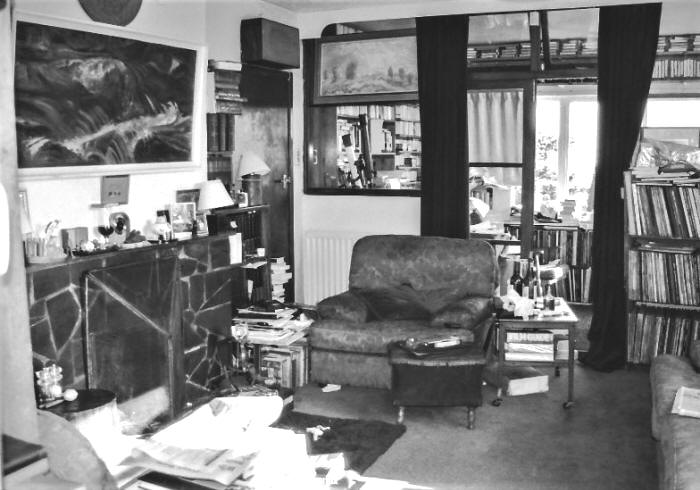
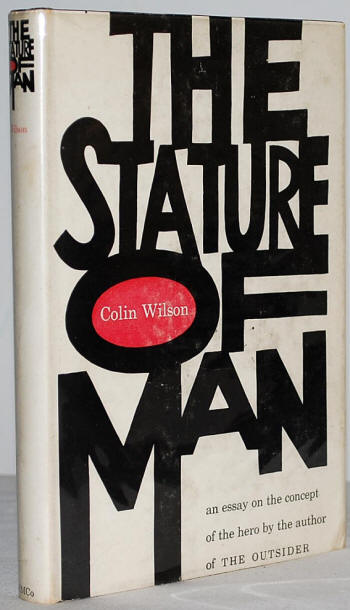
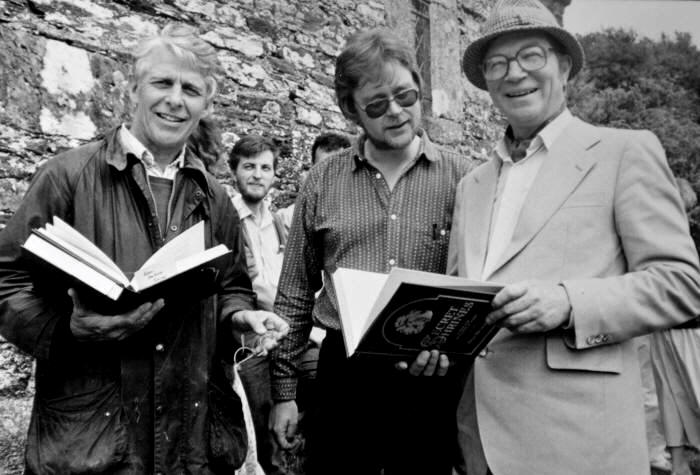

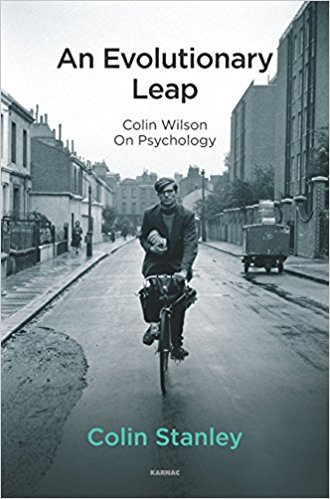 CS Colin's work has become so vast that its impossible to write one
volume about everything so I've divided it up into subjects and written
a student guide to his Outsider cycle, his philosophy books, and another
one on his existential literary criticism, another on his three major
books on the occult, and I've just done one on his psychology books
which includes an essay on his relationship with Maslow. Its called 'An
Evolutionary Leap' and it's got a copy of a photo of Colin on a bike with
a bunch of bananas (right).
CS Colin's work has become so vast that its impossible to write one
volume about everything so I've divided it up into subjects and written
a student guide to his Outsider cycle, his philosophy books, and another
one on his existential literary criticism, another on his three major
books on the occult, and I've just done one on his psychology books
which includes an essay on his relationship with Maslow. Its called 'An
Evolutionary Leap' and it's got a copy of a photo of Colin on a bike with
a bunch of bananas (right).